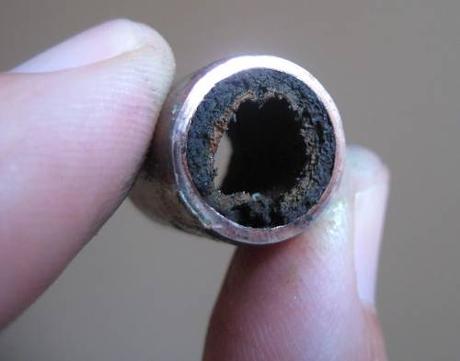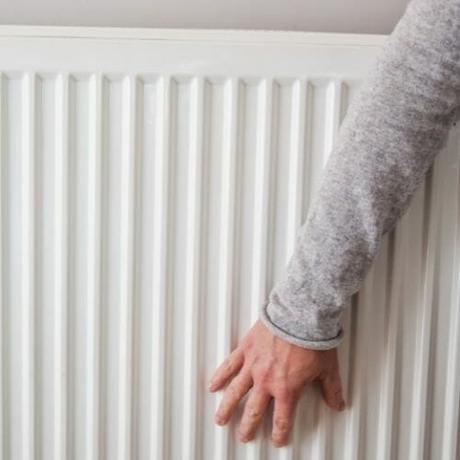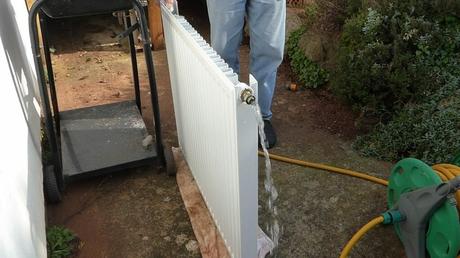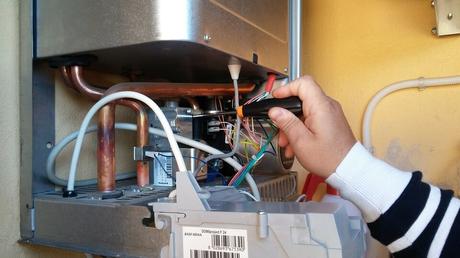Since the development of designer models and the revamp of column classics, radiators have become beautiful interior design features. But, of course, their main job is to keep our homes warm!
So if your radiators feel cold at the bottom, it prevents them from performing properly. Not only that, but the cause of the issue could lead to more expensive problems than a chilly living room.
In this guide, we’ll dive into the details and discuss why your radiator might be cold at the bottom and hot at the top. Plus, we’ll provide some practical solutions to help prevent the problem in the first place!
Why is my radiator cold at the bottom?
If you feel cold patches on the bottom of your radiator when the heating is on, the most common cause is sludge.
Over time, radiator sludge builds up inside the radiator.
Once enough sludge has accumulated, it creates blockages within the radiator’s flow channels.
This means that water is unable to move around the entire radiator efficiently.
Sludge is a thick, heavy substance. Therefore, it sinks and settles at the bottom of the radiator.
This is why you will feel the cold patches along the bottom. Heat rises, but the sludge prevents the hot water from reaching the congested areas.

Why does radiator sludge build up?
Unfortunately, in situations where water and metal meet, other unwanted materials are inevitably formed. In terms of central heating, there is an abundance of both!
Most radiators are made from iron or steel. Water then flows from the boiler around the system. So the combination is a consistent occurrence.
This constant chemical reaction causes iron compounds like magnetite and haematite to form. Plus a damaging mixture of rust, dirt and scale.
You can imagine how easily more and more of this messy matter collects over time!
In extreme cases, the radiator can be filled with so much sludge that the entire bottom half of the radiator can feel cold. But fear not, there are things you can do to fix and prevent this problem!

How to fix radiators that are cold at the bottom
There are a couple of different methods you can use to fix radiators that are cold at the bottom. Each process has its benefits for different situations.
If one radiator is cold at the bottom
If you have noticed that only one radiator has cold patches at the bottom, you could attempt to fix it yourself. To do this, you will need to manually clean the radiator. This is also known as flushing a radiator.
To successfully flush your radiator and remove the sludge, first you need to bleed the radiator.
Then you need to drain the radiator to remove as much of the dirty water as possible. Make sure to protect the floors as you do this and catch the water in a bucket.
Next, you need to remove the radiator from the wall and take it outside to flush. Now it’s time to really get rid of that sludge!
Attach the hose pipe to the radiator valve inlet and turn the tap on full blast. As the clean water flows through the radiator and out of the other inlet, it should bring the dirt, sludge and grime with it.
To ensure all of the sludge has been removed, try tapping the radiator inlet with a rubber hammer.
The idea is to repeat this process by attaching the hose to the other end of the radiator and flushing clean water through it until it runs clear.
For more information on this process, head over to our guide ‘How To Flush A Radiator In 10 Steps’.
If multiple radiators are cold at the bottom
In severe cases, sludge can affect multiple areas of your heating system. This can result in more than one radiator feeling completely cold at the bottom.
If that sounds like your situation, you will need to enlist the help of a heating engineer and request a full system Power Flush. This will usually take around 5 hours for a three-bedroom home with a vented heating system.
The great thing about Power Flushes is that the radiators don’t even have to be removed from the wall. This is because heating engineers have special tools, chemicals and cleaning solutions to totally eliminate and dispose of the sludge and scale.
For more information on this process, head over to our guide ‘What Is A Heating System Flush?’.

Other signs of radiator sludge
In addition to radiators feeling cooler at the bottom, there are a couple of other signals that tell you your radiator is full of sludge.
If you notice any of the issues below, your radiator or radiators may require a flush:
- Radiators need bleeding often.
- Brown liquid when you bleed your radiator.
- Broken or leaking heat pump.
- Boiler makes loud noises.
How to prevent radiator sludge
Like most common heating issues, prevention is more effective than the solution. The good news is, there are a couple of efficient methods to prevent sludge from building up in your heating system.
Add Central Heating Inhibitor
One of the easiest and most effective ways to prevent sludge and keep your system running smoothly is to add central heating inhibitor. It is also a job you can get done yourself! For more info on how and why you should use inhibitor, head over to our guide ‘Why Is Central Heating Inhibitor Important?’.
Add A Scale Reducer
Similarly to inhibitor, a scale reducer can be added to your system to remove the build up of limescale. Less limescale means less chance of sludge building up over time.
Install A Magnetic Filter
Since sludge contains rust and other metallic debris, a good way to prevent the build up is to remove the metallic fragments. That is precisely what the magnetic filter does.
Most metallic filters are added to boilers during installation and they are fixed to the pipe that returns water to the boiler. If your system doesn’t have a filter, contact your heating engineer to fit one for you.

What NOT to do to a cold radiator
If you do notice any cold patches in your radiators, a common mistake you should try and avoid is to turn the thermostat up.
Increasing the temperature on your thermostat will only make your boiler work overtime. But, it will not heat up the cold patches as the build up of sludge will still prevent this from happening.
Are cold radiators a serious problem?
Cold patches on your radiator mean that you are not benefitting from the maximum heat output. Plus, this inefficiency also means that your heating bills will be too high for the amount of heat being provided.
In the long term, the problem could lead to even more expensive issues. Sludge and limescale can damage the internal workings of your central heating system, cause boiler breakdowns and even reduce the lifespan of your boiler because of the high pressure conditions.
Is Your Radiator Cold At The Top?
If you notice your radiator is cold at the top and hot at the bottom, you will need to bleed your radiator to remove the trapped air inside. We’ll take you through the process step by step in our ‘How To Bleed A Radiator’ guide.


